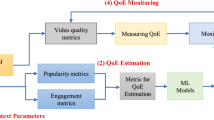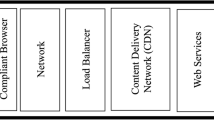Abstract
Interactive online video applications, such as video telephony, are known for their vulnerability to network condition. With the increasing usage of hand-held wireless mobile devices, which are capable of capturing and processing good quality videos, combined with the flexibility in an end-user movements have added new challenging factors for application providers and network operators. These factors affect the perceived video quality of mobile video telephony applications, unlike conventional video telephony over desktop computers. We investigate this impact on video quality of mobile video telephony in varying network conditions and end-users movement scenarios. Based on 312 live traces, we quantitatively derive the correlation between the perceived video quality and the network Quality of Service (QoS) and user mobility. With the results, we develop a Quality of Experience (QoE) prediction model for mobile video telephony using Support Vector Regression techniques. The prediction models display ≈ 0.8 pearson correlation with experimental data. Our methodology and findings can be used to guide the video telephony application providers and network operators to work towards satisfying end-user experience.










Similar content being viewed by others
References
Basak D, Pal S, Patranabis DC (2007) Support vector regression. Neural Inf Process Lett Rev 11(3)
Chan AJ, Pande A, Baik E, Mohapatra P (2012) Temporal quality assessment for mobile videos. In: Proceedings of the ACM Mobicom ’12
Chapelle O, Vapnik V (1999) Model selection for support vector machines. In: Advances in Neural Information Processing Systems 12
Chen KT, Huang CY, Huang P, Lei CL (2006) Quantifying skype user satisfaction. In: Proceedings of the ACM SIGCOMM’06
CISCO (2011) Cisco visual networking index: Global mobile data traffic forecast update, 2011 – 2016. www.cisco.com
Cui L, Allen A (2008) An image quality metric based on corner, edge and symmetry maps. In: Proceedings of the British Machine Vision Conference, Leeds, UK
Dobrian F, Sekar V, Awan A, Stoica I, Joseph D, Ganjam A, Zhan J, Zhang H (2011) Understanding the impact of video quality on user engagement. In: Proceedings of the ACM SIGCOMM 2011 conference
FFMPEG (2013) http://ffmpeg.org/. FFMPEG
Huang J, Xu Q, Tiwana B, Mao Z, Morley Z, Zhang M, Bahl P (2010) Anatomizing application performance differences on smartphones. In: Proceedings of Mobisys ’10
ITU (1993) -T recommendation G.114. Tech rep, International Telecommunication Union
ITU (2002) Bt-500-11: Methodology for subjective assessment of the quality of television picture, international telecommunication union. Tech rep, International Telecommunication Union
ITU (2008) Subjective video quality assessment methods for multimedia applications, international telecommunications union, itu-t. rec. p 910. Tech rep, International Telecommunication Union
Jana S, Pande A, Chan A, Mohapatra P (2013a) Mobile video chat: Issues and challenges. IEEE Commun Mag
Jana S, Pande A, Chan A, Mohapatra P (2013b) Network characterization and perceptual evaluation of skype mobile videos. In: Proceedings of ICCCN
Jana S, Baik E, Pande A, Mohapatra P (2014) Improving mobile video telephony. In: Proceedings of IEEE SECON
Cicco LD, Mascolo VPS (2008) Skype video responsiveness to bandwidth variations. In: NOSSDAV
Marichal X, Ma WY, Zhang H (1999) Blur determination in the compressed domain using DCT information. In: Image Processing, 1999. ICIP 99. Proceedings. 1999 International Conference on, vol 2
NETEM (2013) www.linuxfoundation.org. Netem
O Boyaci HS, Forte AG (2009) Performance of video-chat applications under congestion. In: IEEE International Symposium on Multimedia
OPTICOM (2005) Pevq advanced perceptual evaluation of video quality. OPTICOM GmbH, Germany: PEVQ Whitepaper
Pinson M, Wolf S (2004) A new standardized method for objectively measuring video quality. IEEE Trans Broadcast 50(3):312–322
Qian F, Wang Z, Gerber A, Mao Z, Sen S, Spatscheck O (2011) Profiling resource usage for mobile applications: a cross-layer approach. In: Proceedings of MobiSys ’11
Sat B, Wah B (2006) Analysis and Evaluation of the Skype and Google-Talk VoIP Systems. In: Multimedia and Expo, 2006 IEEE International Conference on
Smola AJ, Schölkopf B (2004) A tutorial on support vector regression. Stat Comput 14(3)
T Hofeld AB (2007) Analysis of Skype VoIP traffic in UMTS: End-to-end QoS and QoE measurements. Comput Netw
Tao S, Apostolopoulos J, Guérin R (2008) Real-time monitoring of video quality in ip networks. IEEE/ACM Trans Netw 16(5)
Wang Z, Bovik AC (2006) Modern Image Quality Assessment. Synthesis Lectures on Image, Video, and Multimedia Processing, Morgan & Claypool Publishers
Wang Z, Bovik A, Evan B (2000) Blind measurement of blocking artifacts in images. In: Image Processing, 2000. Proceedings. 2000 International Conference on, vol 3
Wang Z, Lu L, Bovik AC (2004) Video quality assessment based on structural distortion measurement. Signal Process Image Commun 19(2):121–132
WEKA (2013) http://www.cs.waikato.ac.nz/ml/weka/. WEKA
Zhang X, Xu Y, Hu H, Liu Y, Guo Z, Wang Y (2012) Profiling skype video calls: Rate control and video quality. In: INFOCOM
Author information
Authors and Affiliations
Corresponding author
Appendix A: Support vector regression
Appendix A: Support vector regression
Support Vector Regression (SVR), is a machine learning tool proposed in [3]. We discuss the linear case followed by non-linear SVR algorithm.
Suppose the training data set is as following
where real-valued inputs x i ∈R n, and target y ∈ 𝔑. The objective function is to find function f that returns the best fit i.e. f : 𝔑n → 𝔑 The linear regression function f is given as
where b ∈ 𝔑 and ω ∈ 𝔑n. To avoid over-fitting, a regularization term is introduced to have small ω and can be formulated as the convex optimization problem minimizing the euclidean norm i.e.
The convex optimization problem may not be feasible if the errors are more than ε. Thus, any point outside the ε region contributes to the cost of the function.
SVR introduces slack variables, ξ i and \(\xi ^{*}_{i}\) to cope up with not feasible constraints. The convex optimization can be defined as
where C is a constant known as penalty factor. It consists the trade-off between smaller ω values and ε-insensitive loss function given as
The (13) is the Primal form and handles inequality constraints directly. The dual form obtained by constructing a Lagrange function and taking partial derivative w.r.t. primal variables is given as-
where \(\alpha _{i}, \alpha _{i}^{*}\) are Lagrange multipliers. The steps for partial derivative can be looked upon in [1]. Interestingly, the partial derivative also gives following equation:
Hence, the SVR linear regression reduces to
The (9)–(19) discussed so far are simple cases when SVR algorithm is used for a linear function. SV algorithm can be made non-linear by simply substituting every instance of x with Φ(x). The approach becomes infeasible when x is mapped to higher-dimensions. Using kernel method, explicit substitution of x with Φ(x) is avoided. The kernel function is given as -
The commonly used kernel functions are polynomial kernels: K(x,y)=(x T y+1)d and radial basis function (RBF) kernels: \(K(x, y) = exp\left (\frac {-||x - y||^{2}}{2 \sigma ^{2}}\right )\) . Hence, from (19) and (20), the solution function can be written as
Rights and permissions
About this article
Cite this article
Jana, S., Chan, A., Pande, A. et al. QoE prediction model for mobile video telephony. Multimed Tools Appl 75, 7957–7980 (2016). https://doi.org/10.1007/s11042-015-2711-5
Received:
Revised:
Accepted:
Published:
Issue Date:
DOI: https://doi.org/10.1007/s11042-015-2711-5




